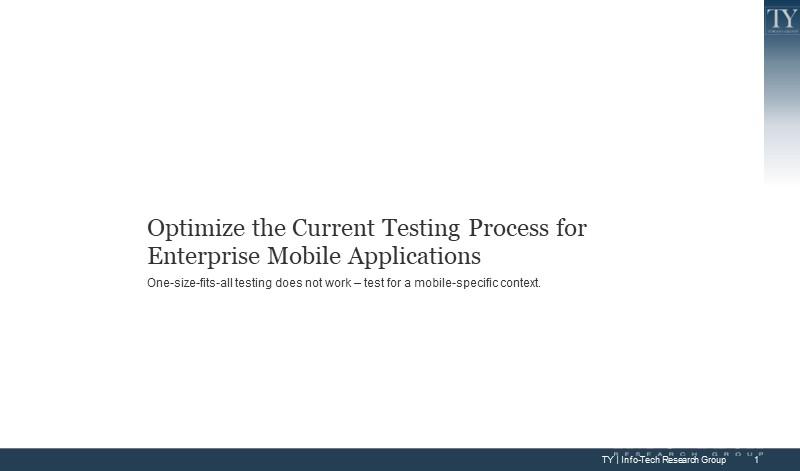
Optimize the Current Testing Process for Enterprise Mobile Applications
- Your team has little or no experience in mobile testing.
- You need to optimize current testing processes to include mobile.
- You need to conduct an RFP for mobile testing tools.
Our Advice
Critical Insight
- One-size-fits-all testing won’t work for mobile. The testing tools are fragmented.
- Mobile offers many new test cases, so organizations can expect to spend more time testing.
Impact and Result
- Identify and address gaps between your current testing process and a target state that includes mobile testing.
- Establish project value metrics to ensure business and technical requirements are met.
Optimize the Current Testing Process for Enterprise Mobile Applications Research & Tools
Besides the small introduction, subscribers and consulting clients within this management domain have access to:
1. Assess the current testing state
Determine a starting point for architecture and discuss pain points that will drive reusability.
- Storyboard: Optimize the Current Testing Process for Enterprise Mobile Applications
- Mobile Testing Project Charter Template
- Visual SOP Template for Application Testing
2. Determine the target state testing framework
Document a preliminary list of test requirements and create vendor RFP and scoring.
- Test Requirements Tool
- Request for Proposal (RFP) Template
3. Implement testing tools to support the testing SOP
Create an implementation rollout plan.
- Project Planning and Monitoring Tool
Infographic

Workshop: Optimize the Current Testing Process for Enterprise Mobile Applications
Workshops offer an easy way to accelerate your project. If you are unable to do the project yourself, and a Guided Implementation isn't enough, we offer low-cost delivery of our project workshops. We take you through every phase of your project and ensure that you have a roadmap in place to complete your project successfully.
1 Assess the Fit for Test Process Optimization
The Purpose
Understand mobile testing pain points.
Evaluate current statistics and challenges around mobile testing and compare with your organization.
Realize the benefits of mobile testing.
Understand the differences of mobile testing.
Assess your readiness for optimizing testing to include mobile.
Key Benefits Achieved
Preliminary understanding of how mobile testing is different from conventional approaches to testing apps.
Understanding of how mobile testing can optimize your current testing process.
Activities
1.1 Understand the pain points experienced with mobile testing
1.2 Evaluate current statistics and challenges of mobile testing and compare your organization
1.3 Realize the benefits that come from mobile testing
1.4 Understand the differences between mobile app testing and conventional app testing
1.5 Assess your readiness for optimizing the testing process to include mobile
Outputs
Organizational state assessment for mobile testing
2 Structure & Launch the Project
The Purpose
Identify stakeholders for testing requirements gathering.
Create a project charter to obtain project approval.
Present and obtain project charter sign-off.
Key Benefits Achieved
Well documented project charter.
Approval to launch the project.
Activities
2.1 Identify stakeholders for testing requirements gathering
2.2 Create a project charter to obtain project approval
2.3 Present & obtain project charter sign-off
Outputs
Project objectives and scope
Project roles and responsibilities
3 Assess Current Testing State
The Purpose
Document your current non-mobile testing processes.
Create a current testing visual SOP.
Determine current testing pain points.
Key Benefits Achieved
Thorough understanding of current testing processes and pain points.
Activities
3.1 Document your current non-mobile testing processes
3.2 Create a current state visual SOP
3.3 Determine current testing pain points
Outputs
Documented current testing processes in the form of a visual SOP
List of current testing pain points
4 Determine Target State Testing Framework
The Purpose
Determine your target state for mobile testing.
Choose vendors for the RFP process.
Evaluate selected vendor(s) against testing requirements.
Design mobile testing visual SOP(s).
Key Benefits Achieved
Prioritized list of testing requirements for mobile.
Vendor selection for mobile testing solutions through an RFP process.
New SOP designed to include both current testing and mobile testing processes.
Activities
4.1 Determine your target state for mobile testing by following Info-Tech’s framework as a starting point
4.2 Design new SOP to include testing for mobile apps
4.3 Translate all considered visual SOP mobile injections into requirements
4.4 Document the preliminary list of test requirements in the RFP
4.5 Determine which vendors to include for the RFP process
4.6 Reach out to vendors for a request for proposal
4.7 Objectively evaluate vendors against testing requirements
4.8 Identify and assess the expected costs and impacts from determining your target state
Outputs
List of testing requirements for mobile
Request for Proposal
5 Implement Testing Tools to Support Your Testing SOP
The Purpose
Develop an implementation roadmap to integrate new testing initiatives.
Anticipate potential roadblocks during implementation rollout.
Operationalize mobile testing and ensure a smooth hand-off to IT operations.
Key Benefits Achieved
Creation of implementation project plan.
List of approaches to mitigate potential implementation roadblocks.
Achieving clean hand-off to IT ops team.
Activities
5.1 Develop a project plan to codify your current understanding of the scope of work
5.2 Anticipate potential roadblocks during your tool’s implementation
5.3 Operationalize your testing tools and ensure a smooth hand-off from the project team
Outputs
Mobile testing metrics implementation plan
6 Conduct Your Retrospectives
The Purpose
Conduct regular retrospectives to consider areas for improvement.
Adjust your processes, systems, and testing tools to improve performance and usability.
Revisit implementation metrics to communicate project benefits.
Leverage the lessons learned and apply them to other projects.
Key Benefits Achieved
Project specific metrics.
Discovery of areas to improve.
Activities
6.1 Conduct regular retrospectives to consider areas for improvement
6.2 Revisit your implementation metrics to communicate project benefits to business stakeholders
6.3 Adjust your processes, systems, and testing tools to improve performance and usability
6.4 Leverage the lessons learned and apply them to other IT projects
Outputs
Steps to improve your mobile testing